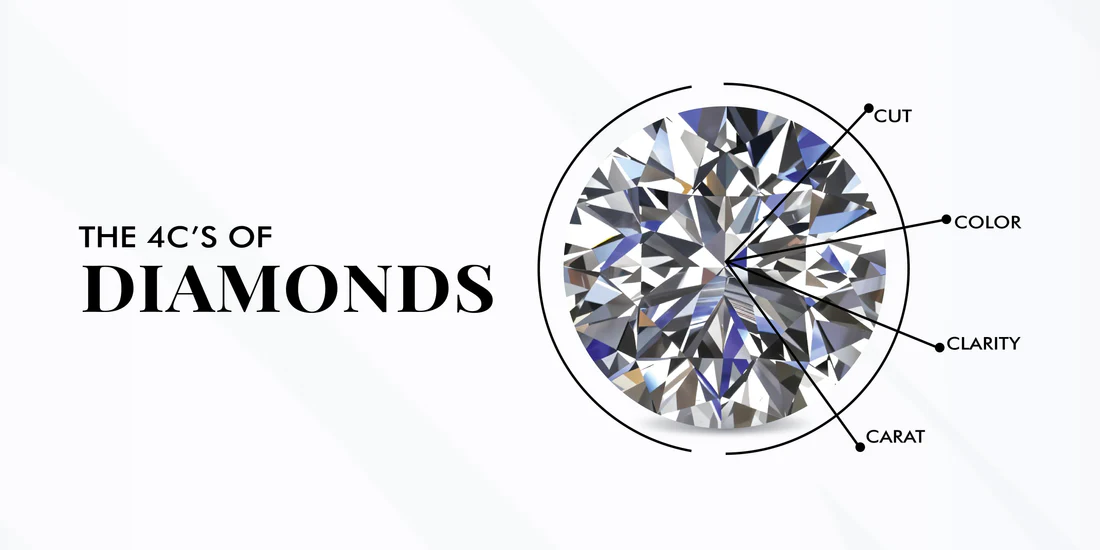The Real Sparkle: Understanding the 4Cs of Lab Diamonds (From Someone Who’s Been Behind the Counter)

I still remember the first time a customer asked me, “So… can you really tell the difference between a lab diamond and a natural one?”
I laughed — not mockingly, just the kind of laugh that says, “You’re not the first to ask that.” Because honestly, most people can’t tell. Even with years of experience as a jeweller, I often have to use specialised tools to spot the difference.
That’s the beauty of lab created diamonds — they’ve made the world of fine jewellery more accessible without losing the romance or brilliance of a natural gem. And when you understand the 4Cs of lab diamonds, you’ll see just how much thought, science, and craftsmanship go into creating that sparkle on your finger.
So, let’s unpack the 4Cs — not like a textbook lesson, but like a friend showing you what to look for before you make a lifetime purchase.
1. Cut: The Sparkle’s Secret Weapon
If you’ve ever seen a diamond that catches the light just right — that’s cut doing its magic.
Cut isn’t about the shape (round, princess, oval, etc.) but about how the facets are proportioned and polished. Think of it like the way a musician tunes an instrument. If it’s done perfectly, the performance shines.
A well-cut lab diamond reflects light in three beautiful ways:
-
Brightness, the white light that flashes from the surface.
-
Fire, those rainbow-like bursts when light bends through the stone.
-
Scintillation, the sparkle that dances when the diamond moves.
And here’s the thing — lab diamonds are grown in controlled environments, so cutters often start with near-perfect raw material. That means they can focus on precision, symmetry, and artistry rather than working around natural flaws or irregularities.
If you’re ever choosing between two diamonds, pick the better cut over size or clarity. Trust me — even a smaller, well-cut diamond will outshine a bigger, poorly cut one every time.
2. Colour: The Subtle Art of “White”
Colour in diamonds is one of those details that sounds simpler than it is. The grading scale runs from D (colourless) to Z (light yellow or brown).
But here’s a little insider truth — once you go beyond “G” or “H” on the scale, most people can’t tell the difference with the naked eye.
Lab created diamonds often fall into the near-colourless range naturally, which means you’re getting that bright, icy look without paying the steep premium that comes with a “D” or “E” grade mined diamond.
Sometimes customers come in asking for the “best” colour, but I always ask — best for who? Some people actually prefer a slightly warmer tone; it can give the diamond a vintage, romantic character. Like the way an old photograph feels more real than a perfectly edited one.
If you’re curious about the details, there’s a really helpful guide that breaks down how each grade looks and why it matters — the 4Cs of lab diamonds chart is worth a quick read before you start shopping.
3. Clarity: The Diamond’s Little Fingerprints
Every diamond has a story, even those made in a lab.
Clarity is all about the tiny inclusions or surface blemishes that form during growth. Natural diamonds have these because they grow under immense pressure underground. Lab diamonds? Well, they grow in chambers, so their inclusions tend to be smaller and more predictable.
The clarity scale runs from Flawless (FL) to Included (I1, I2, I3), and the differences can be microscopic. A diamond graded VS1 or VS2 (Very Slightly Included) is often completely clean to the naked eye — that’s the sweet spot most jewellers recommend.
Here’s what’s interesting: because the conditions in the lab are controlled, scientists can minimise these inclusions without sacrificing the authenticity of the stone. So you’re still getting a unique gem, just one that’s crafted with intention.
It’s a bit like artisan bread made in a bakery instead of a factory — still real, still unique, but with care behind every step.
4. Carat: The One Everyone Talks About
Ah, carat — the headline act.
It’s the measure of weight, not size, though we often use it as shorthand for both.
Here’s a reality check: two diamonds with the same carat weight can look completely different if their cuts differ. A shallow cut might make a diamond appear larger, but it’ll lose brilliance. A deep cut might sparkle more, but it could look smaller face-up.
That’s why, when it comes to lab created diamonds, carat becomes a little more fun. You can play around with size and style without your budget spiralling out of control.
Many couples these days are going a few tenths of a carat bigger — not to show off, but because it’s finally possible. The cost difference between a mined 1-carat diamond and a lab-grown one can be thousands of dollars, which makes a major difference when you’re planning a wedding, buying a home, or simply trying to be financially smart.
If you’re still weighing up whether lab diamonds are “real” diamonds — they are. Chemically, physically, and optically identical. The only difference is where they were born: deep underground versus in a lab powered by human innovation.
Why the 4Cs Matter Even More for Lab Diamonds
Now, you might be thinking, “If lab diamonds are made in controlled conditions, do the 4Cs still matter?”
Absolutely — maybe even more so.
Because with lab created diamonds, you’re often comparing stones that are already high quality. That means small differences in cut or colour can really stand out. Understanding the 4Cs helps you make a choice based on what you value most — brilliance, size, purity, or overall presence.
Some buyers care about precision and science. Others want something that sparkles like crazy in the sunlight. There’s no wrong answer, but knowledge gives you the confidence to choose what truly feels right.
The Emotional Side of It All
It’s funny, isn’t it? For something so technical — carats, clarity, refractive index — diamonds carry so much emotion. Engagements, anniversaries, family heirlooms… they’re markers of our lives.
When lab created diamonds first entered the market, some people were hesitant. They worried it might take away from the romance of a natural gem. But over the years, that’s changed.
I’ve seen couples light up when they realise they can choose an ethical, sustainable diamond without compromise. One bride told me she loved knowing her ring had “no history of conflict, no environmental guilt — just a love story and some beautiful science.”
That sentiment has stayed with me.
If you’re someone who values transparency — in your relationships, your purchases, your lifestyle — lab diamonds align perfectly with that mindset. And the fact that they’re more affordable doesn’t hurt either. (There’s a great read on how lab created diamonds make elegant wedding bands possible without blowing the budget.)
A Jeweller’s Takeaway
After years in the industry, I’ve come to see diamonds not just as stones, but as stories captured in light.
Whether they’re mined from the earth or born in a lab, they reflect human emotion — love, achievement, commitment.
The difference now is that you have choice. You can embrace sustainability, affordability, and ethical sourcing without sacrificing the beauty that makes a diamond timeless.
So when you next walk into a jewellery store, or scroll through engagement rings online, take a moment to remember the 4Cs. They’re not just technical specs — they’re the keys to finding a diamond that feels right for you.
And if you find yourself staring into that perfect sparkle, losing track of time for a moment… well, that’s when you’ll know. You’ve found the one.







